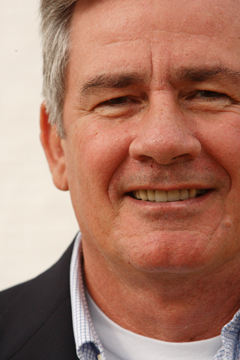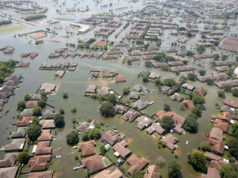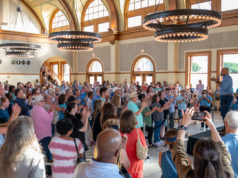Tarrant County College officials are late on another key permit for the downtown campus.
By BETTY BRINK
“I had no idea,” Joe Hudson said. The Tarrant County College District trustee was shocked to find out from a reporter that the TCCD’s problems with the U. S. Army Corps of Engineers hadn’t ended when the college bought the RadioShack complex as a substitute for its ambitious and deeply flawed riverside campus, under construction a few blocks to the east.
A major stumbling block for that campus, and one that ultimately led college trustees to scrap half the plan, was the failure of college administrators to apply for a required permit from the Corps before construction began. The permit was needed for the portions of the campus that would have affected the Trinity River, including piers to be sunk deep into the north bank levee to support a pedestrian bridge, and dozens of buildings planned in the flood plain. By the time the application was filed, construction crews had already gouged a large swath out of the south bank bluff where Fort Worth was founded. Eventually, the north bank portion of the plan was abandoned, and college trustees have stopped all but minimal construction work on the south bank while they assess the possibility of selling off the whole campus, including the unfinished buildings.
Now, however, it appears that administrators’ failure to get another permit from the Corps could affect even the salability of the property, much less continued construction. Hudson and his fellow board members have been kept in the dark – again – about a potential obstacle that the administration knew of but has thus far failed to address.
Joseph Murphey, historic architect with the Corps’ Fort Worth office, said TCCD must get approval from the Tarrant Regional Water District, which owns and operates the floodway, and then a permit from his agency, for a drainage system that will empty storm water collected on the south bank campus directly into the river. That portion of the river is under the direct supervision of the Corps.
The permit is no routine form to be filled out, either. As with the overall downtown campus plan, the outfall permit process will open up the south bank project to questions of its impact on the historic bluff and surrounding area – concerns that have already gotten the district into big trouble with historic preservationists.
“I thought we had all the permits we needed. Now this could gravely impact the disposition of this property,” Hudson said. “Obviously, if we’re going to sell that property, which is under serious consideration [by the board], we’re going to need that permit.”
Hudson was elected to the board this year primarily on the promise that he would stop the downtown campus. Costs of the project, pushed by controversial TCC Chancellor Leonardo de la Garza, had risen to $350 million with no end in sight. In June, trustees decided to buy the RadioShack property as a replacement, in order to stop digging itself any deeper into a financial hole. Hudson and fellow trustee Bobby McGee have also lobbed heavy criticism at de la Garza for his practices of secrecy and failure to give full information about the project to the board and the public. Calls and emails from Fort Worth Weekly to de la Garza and other TCC administrators for comment on this story were not returned.
Right now, the only work being done is to close in the buildings from the weather, without finishing them out, Hudson said. At the last budget meeting, de la Garza asked for and got $17 million to do more work at the site, with Hudson and long-time trustee McGee the only no votes.
Hudson said the district is likely to lose money on any sale of the downtown property (though less than if the project were completed). He said that his survey of downtown building properties show they are selling for around $200 to $225 per square foot, but that completing the buildings – on which the district has already spent $100 million, with an estimated $70 million more needed to complete them – would run the costs up to more than $800 per square foot, not counting the price of the land. “Now we may have added costs because of this new permit,” he said. Hudson said he is also worried because he has asked for, but has not received, information on how much TCCD is bound by contract to pay to builders and suppliers even if the construction is stopped now.
Woody Frossard, environmental director for the Tarrant Regional Water District, said TCCD representatives came to him some time ago and asked if there were “alternatives” to a buried pipeline to gather storm water from the site. “They didn’t want to bury the pipe, for some reason,” Frossard said. Last month, water district officials denied the request for an alternative, telling college officials that the pipe had to be buried.
Frossard said he hasn’t heard from them since, and no permit has been applied for. It’s not mandatory, but advisable, to obtain any permit before construction starts, Murphey said, and he and Frossard agreed that the storm water outfall to the Trinity will not be allowed without a permit, effectively stopping any disposition of the property until the permit clears all of its hurdles.
In fact, the outfall permit process is looking a lot like the fiasco that the college got into by failing to file in a timely manner for a Corps permit for the original plan.
“Starting overall construction before [getting] a permit runs the risk of complicating related issues such as [compliance with the National Historic Preservation Act], where adverse effects could be reduced or avoided in the planning stages through consultation,” Murphey said.
Obtaining the permit from the Corps will require an environmental impact and water quality assessment. And because the activity is on the bluff, which the Corps has designated a “traditional cultural property” subject to inclusion in the National Register of Historic Places, the permit also triggers the need for a cultural assessment under the NHPA – the same thing that happened with the original downtown campus plan, Murphey said.
Stakeholders such as Historic Fort Worth and the Tarrant County Historical Commission will be asked to participate once the permit is filed, Murphey said, and historic properties will be identified that could be directly or indirectly affected by the outfall. The permit process will take into consideration not only the direct effect of the storm water outfall on the river, but also the question of the need for the outfall – that is, the impact of the buildings being built on the bluff, he said.
The previous application, Murphey pointed out, resulted in findings by the Corps of “adverse effects to the bluff” – because of the huge cut in the escarpment and the demolition of several nearby historic buildings before an assessment of their cultural value to Fort Worth could be made.
Local historic preservationist Kip Wright said in an earlier interview that he and others in the city’s preservation community were incensed that the college was able to take out such a huge chunk of the bluff, where thick vegetation and trees formed a verdant oasis along the river at the north end of downtown, with no one having the power to stop it.
Murphey said that even with the TCC construction, the bluff is still eligible for inclusion in the National Register because most of its integrity as a green space remains, along with its relationship to the history of Fort Worth – the founding of the city, the cattle drives, the Chisholm Trail, the location of the Tarrant County Courthouse, and the bluff’s role as a natural boundary, across the river from the levee system that shaped the urban development of the city following the destructive flood of 1949.
One of the unintended consequences of TCC’s failure to file for its permits may be a “lesson learned” for future developers of the Trinity River Vision, the grandiose scheme to redirect the flow of the river, form a town lake, and promote development around the lake and along the river banks. It is a “reasonable assumption,” Murphey said, that future developers will look at what happened with the TCC campus and seek ways to avoid the same pitfalls as they deal with historic preservation issues.
One thing he wants developers and others to understand, he said, is that historic preservation is not about stopping progress or blocking change, it is rather about “mediating change with sensitivity” to a community’s unique past.











